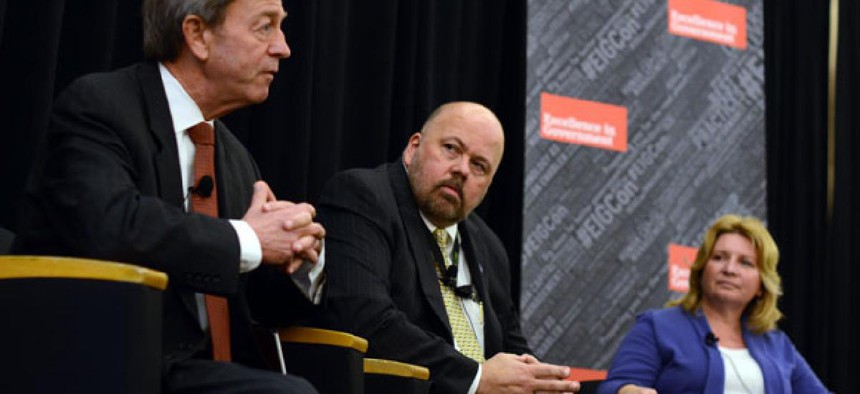
Caitlin Fairchild/Govexec.com
Incentives, not mobility, called key to improving Senior Executive Service
OPM and industry officials discuss keys to improving SES.
Mobility might not be the only key to improving the Senior Executive Service, as a recent study suggests.
Speaking Monday at a panel discussion hosted by Government Executive Media Group, Senior Executives Association General Counsel Bill Bransford suggested new initiatives that would require SES members to serve at more than one government agency as part of their service make more sense at some agencies than at others.
For example, requiring mobility at an agency with a targeted, unique mission, such as the Housing and Urban Development Department or the Securities and Exchange Commission, would be less beneficial to those agencies than requiring mobility at the Defense or Homeland Security departments, he said.
A recent report by the Partnership for Public Service and consulting firm McKinsey & Co. on mobility within the SES found that 48 percent of senior executives have never changed positions and only 8 percent have switched agencies during their careers.
Another recent survey of GS-14 and GS-15 employees showed that employees who are qualified to move into career SES positions are dissuaded from applying due to an unfavorable risk-to-reward ratio, concerns about mobility and a lack of work-life balance. In some cases, a GS-15 employee could earn the same salary in the SES.
Legislation proposed by Sen. Daniel Akaka, D-Hawaii, would reduce the percentage of noncareer SES appointees as part of an effort to make the SES more attractive to career employees. Akaka’s bill also would require all Cabinet-level agencies to have at least one career SES at the principal deputy assistant secretary level for every assistant secretary or comparable position. Currently, noncareer SES membership is capped at 25 percent of allocated positions -- including those that remain empty. The bill would lower that ceiling to 15 percent of filled positions.
Both Bransford and Angela Bailey, associate director of employee services at the Office of Personnel Management, agreed the reward-to-risk ratio has become skewed for federal employees considering joining the SES, but debated whether or not mandating incentives would improve the “cadre of senior professionals” created in 1978.
When a GS-15 employee does not want to join the SES, it “is sort of like an Army colonel not wanting to be a general,” Bransford said. "That’s what we have in the SES today." Offering performance rewards, such as a high-three annuity calculation for career SES employees -- a provision included in the Akaka bill -- might motivate more qualified candidates to apply, he said, adding he has heard that promotion panels “are less and less satisfied with applicants for SES.”
Bailey emphasized that the Senior Executive Service should be made up of candidates who want to be part of the service for reasons beyond monetary awards. “I’m not sure everyone is in [SES] for the money,” she said.
Regarding mobility, Bailey said agencies can benefit from a mix of institutional knowledge and leadership with experience in “other types of cultures,” adding that blend had “created tension” at OPM that has enabled the agency to deliver on initiatives such as improving USAJobs.gov and hiring reform.






